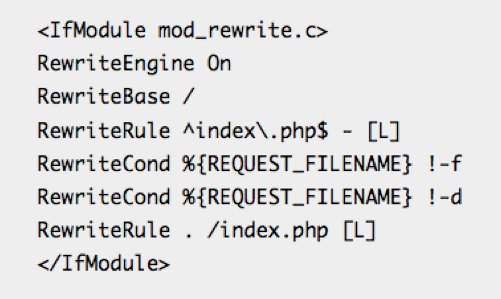Last week we published a blog about Creating NGINX Rewrite Rules. In this complementary blog, we’ll discuss how to convert Apache HTTP server rewrite rules to NGINX syntax (the conversions are the same for NGINX Open Source). You need to convert to NGINX rewrite rules when you place NGINX in front of your Apache servers to take over as the reverse proxy or load balancer, or when you replace Apache web servers with NGINX web servers. Keep in mind that NGINX and NGINX Plus do not support per‑directory configuration files (Apache’s .htaccess files), so you need to convert them in particular.
We’ll assume you’re familiar with Apache rewrite rules and with how NGINX Plus processes URLs. For a review of the return, rewrite, and try_files directives in NGINX Plus and NGINX, see Creating NGINX Rewrite Rules.
Converting a Rule that Adds the www Prefix
This Apache rule adds the www prefix to the URL:
RewriteCond %{HTTP_HOST} example.org
RewriteRule (.*) http://www.example.org$1The following NGINX configuration is the correct conversion. The first server block matches requests to example.org and redirects them permanently to www.example.org. The second server block matches the rewritten URL (and all other requests to www.example.org).
# USE THIS CONVERSION
server {
listen 80;
server_name example.org;
return 301 http://www.example.org$request_uri;
}
server {
listen 80;
server_name www.example.org;
# ...
}The following might seem like a natural way to convert the Apache rule to an NGINX rewrite rule, but we don’t recommend it. Compared to the recommended conversion, it requires two extra processing stages: NGINX must first check the if condition, and then evaluate the regular expression in the rewrite directive (simple as it is).
# NOT RECOMMENDED
server {
listen 80;
server_name www.example.org example.org;
if ($http_host = example.org) {
rewrite (.*) http://www.example.org$1;
}
# ...
}Converting an “Is Not” Rule
This Apache rule matches URLs that are “not example.com and not www.example.com” (you could call this “upside‑down” logic) and rewrites them to www.example.com:
RewriteCond %{HTTP_HOST} !example.com
RewriteCond %{HTTP_HOST} !www.example.com
RewriteRule (.*) http://www.example.com$1For the NGINX conversion, we explicitly define a server block that combines the “positive” versions of the Apache RewriteCond directives (that is, it matches URLs that start with example.com or www.example.com), and another server block that matches what is now better characterized as “everything else.” For an explanation of how the second server block works, see “Redirecting All Traffic to the Correct Domain Name” in Creating NGINX Rewrite Rules.
server {
listen 80;
server_name example.com www.example.com;
# ...
}
server {
listen 80 default_server;
server_name _;
return 301 http://www.example.com$request_uri;
}Converting Rules that Enable WordPress Pretty Permalinks
WordPress.org distributes a basic default .htaccess file with the following Apache directives that enable pretty permalinks:
<IfModule mod_rewrite.c>
RewriteEngine On
RewriteBase /
RewriteRule ^index.php$ - [L]
RewriteCond %{REQUEST_FILENAME} !-f
RewriteCond %{REQUEST_FILENAME} !-d
RewriteRule . /index.php [L]
</IfModule>Here’s the NGINX equivalent:
location / {
try_files $uri $uri/ /index.php?$args;
}For more information about enabling pretty permalinks for WordPress with NGINX, see WordPress permalinks at nginxlibrary.com.
Converting Rules that Forward Dynamic Requests to an App Server
Administrators often use Apache rewrite rules like the following to serve static assets directly if they exist and forward dynamic requests to an application server.
DocumentRoot /var/www/myapp.com/current/public
RewriteCond %{DOCUMENT_ROOT}/system/maintenance.html -f
RewriteCond %{SCRIPT_FILENAME} !maintenance.html
RewriteRule ^.*$ %{DOCUMENT_ROOT}/system/maintenance.html [L]
RewriteCond %{REQUEST_FILENAME} -f
RewriteRule ^(.*)$ $1 [QSA,L]
RewriteCond %{REQUEST_FILENAME}/index.html -f
RewriteRule ^(.*)$ $1/index.html [QSA,L]
RewriteCond %{REQUEST_FILENAME}.html -f
RewriteRule ^(.*)$ $1.html [QSA,L]
RewriteRule ^/(.*)$ balancer://app-server_cluster%{REQUEST_URI} [P,QSA,L]Specifically, the blocks of rules perform these functions:
- The
DocumentRootdirective specifies the local disk directory where content is stored. - The first block of rules detects whether the file /system/maintenance.html exists – it’s a common practice among website administrators to create this file as a signal that the website is temporarily unavailable due to maintenance. If file exists, it is served no matter what file is requested (effectively, the rule rewrites all requests to maintenance.html). Presumably, the rewrite results in the sending of a maintenance notification to the browser.
- The next three blocks serve these static assets if they exist:
- The requested file
- The index.html file in the directory named at the end of the URL
- Any file with the .html extension
- The final rule comes into play if none of the three types of file exist. It passes the request to a cluster of application servers.
Here’s the conversion for NGINX. The root directive corresponds to the Apache DocumentRoot directive. The try_files directive replaces the remaining rules, using a named location (@app-server_cluster) as the final rewrite and defining a corresponding location block that proxies requests to the application server:
location / {
root /var/www/myapp.com/current/public;
try_files /system/maintenance.html
$uri $uri/index.html $uri.html
@app-server_cluster;
}
location @app-server_cluster {
proxy_pass http://app-server;
}
